TIFF Countdown -1: Low Life / 388 Arletta Avenue / Back to Stay / Elena / The Forgiveness of Blood / Good Bye / Gypsy / Leave It On the Floor / Mr. Tree / The Patron Saints / Sleeping Beauty / Smuggler / Take This Waltz / Volcano / Whores’ Glory
Cinema Scope 48 Preview: Low Life (Nicolas Klotz & Elisabeth Perceval, France)—Special Presentations
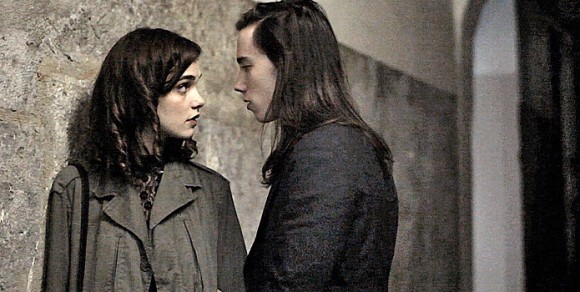 By Andréa Picard
By Andréa Picard
“Two types of film: those that employ the resources of the theatre (actors, directors, etc…) and use the camera in order to reproduce; those that employ the resources of cinematography and use the camera to create.” —Robert Bresson, Notes sur le Cinématographe
“Art is like a fire; it is born out of what it burns.”—Jean-Luc Godard, JLG/JLG
Mining the proverbial depths of despair is a romantic mainstay of artistic production, period. In the cinema, Béla Tarr has mastered miserabilism (for better and for worse) and as much as we want and expect another great film from the dour Hungarian, The Turin Horse does appear to be a likely last outing in a “Where do we go from here?” equation. That Nietzsche served as fodder makes Tarr’s last film pronouncement all the more believable, accompanied by howling winds strong enough to annihilate society as a whole and a single boiled potato for our meagre Last Supper. Yet, pessimism by way of contemporary philosophy (itself of the pessimistic persuasion) is more of a French specialty, especially when contemporaneity is wracked with repressive guilt and the spectres of a sodden history, the trespasses of the Occupation never distant. An interesting comparative study could be made between Godard’s Film socialisme (2010), with its veneer of essayistic opacity and its playful irreverence toward its own enjeux, and Nicolas Klotz and Elizabeth Perceval’s Low Life, a stylized, neo-gothic nocturne with traces of trance and a healthy dose of soixante-huitard nostalgia. The former has a significant cameo by Alain Badiou, while the latter quotes him and a host of other philosophers and writers in a pseudo-Nouvelle Vague (1990) literariness of fragmented, floating citations and abstracted monologues.
Godard may have been kidding when he suggested that his preferred method of dissemination for his latest film was to send teenagers out in a hot air balloon and have them land randomly with copies in hand. But the implication was clear: that the cinema should function as an intimate and meaningful encounter with individuals, not as a mass block (or a block of mass), that the space of discourse needed in today’s world is rarely accorded. Klotz and Perceval have, in some ways, enacted this scenario by engaging in a socially aware cinema from the ground up. Profoundly philosophical—Agamben, the philosopher also known for his cameo in Pasolini’s The Gospel According to Saint Matthew (1964), was the driving spirit behind their last film, La question humaine (2007)—their films harbour the influence of their peers, such as the prolific art historian Georges Didi-Huberman, with whom they have conducted workshops and pre- and post-film discussions. That “pre” is not prior to projection, but prior to shooting. Field research has always been an integral part of the duo’s writing-filmmaking process; their longish gestation periods are spent on roving workshops and feedback sessions with (non-)actors, classrooms, and philosopher friends.
As was the case for their oddly beautiful and radical trilogy consisting of Paria (2000), La blessure (2004), and La question humaine, their latest film, Low Life—the first to bear both their names as director—grew out of theatrical exercises and collaborative research. In 2009, Klotz and Perceval held a residency at the controversial CENTQUATRE, an artist incubator in the former Pompes funèbres de Paris in the 19th arrondissement, a gorgeous, labyrinthine space consumed by closed-door artist studios, which also recently housed filmmaker Sylvain George, there to edit some of his Qu’ils réposent en révolte (figures de guerres)—reviewed and interviewed in the last issue of Cinema Scope and sharing in many of the duo’s concerns—and formidable young critics Antoine Thirion and Eugenio Renzi with their online journal Independencia, so titled after Raya Martin’s film. (Oh yes, and Tricky was there once too, with naked photos of himself posted to the concrete walls…)
Klotz and Perceval’s time there as artists-in-residence was spent researching and laying the groundwork for Low Life, a continuation of their political preoccupations and themes, such as a literal body politic (where carnality is carrier and transmitter of historical trauma, especially illegal bodies), language laden with aphoristic truisms, and disaffected and disenfranchised people, in this case les sans-papiers living in the underworld of Lyon. As a confused, communal group of young friends and lovers who largely live by night freely exchanging wine for café in the morning, ebb and flow between languorous existential musings, meaningful encounters, barricading illegal squats and revelling in an intoxicated haze, the film eludes its own present by conflating France’s pressing issue of the day—Sarkozy’s puerile and abhorrent approach to immigration—with a ‘60s-era verve for revolution. Cross-pollinating Bresson (Le diable probablement, 1977), Pedro Costa (In Vanda’s Room, 2000; Colossal Youth, 2006) and Philippe Garrel (Les amants réguliers, 2006) by way of Jacques Tourneur (I Walked with a Zombie, 1943), Jean Rouch (Les maîtres fous, 1955) and Peter Watkins’ ethos and obsession with a mediatized society, Low Life is surprisingly, perhaps even treacherously, original while steeped in myriad literary, philosophical, and cinephilic references.
It all begins with Antigone (yes, Straub-Huillet are couched in there too, in solidarity, but also because of Notre musique [2004]), barefooted and goldilocked as she ambles down a darkened street, her eyes wild with abandon and emitting an intensity vacillating between life and death. She’s bewitched by her text; the lines of desperation that she repeats are not hers alone, though she incarnates them as ferociously as if her life depended on it. A haunting preface: Low Life is a portrait of an ambling youth, entranced by today’s society, adrift in a world of undetermined ideology and whose value system exists far below the surface (hence the film’s title). Caught up in a sort of tropical malady and stoking the embers beneath their inherited ruins, these youths depend on love, as well as their impulse to mitigate against society’s injustices in order to combat the phantasms of emptiness, however naïve or altruistic. Proving Bresson’s dialectical statement about two types of film to be false (or, at least, too reductive), Klotz and Perceval adeptly use theatrical artifice in order to create rather than simply reproduce. Low Life is replete with bold facial close-ups and staid scenes that defy their own theatricality, that are raw, intimate, stylized, and disarmingly hungry despite their torpour. The film’s affectations are not dissimilar to those in Le diable probablement; in fact, the latter’s suicidal protagonist Charles and ecological clarion call are both subsumed in Low Life as a regenerated and regurgitated form of pessimism toward our contaminated present. (Bresson had said that he was pressed to make the film, which was infamously banned in France for incitement to suicide, because of “the mess we made of everything,” and “the shocking indifference of the people, except for certain young people of today, who are more lucid.”)
Bresson’s film is admittedly also about beauty—physical beauty, angelic and doomed. His Charles, with his long, straight hair and dreamy stare, is ethereal, not unlike Low Life’s Charles, who, spurned by his lover Carmen, drifts alone in a depressive state. As he listens to his iPod and perches on the base of a marble statue, his gaze turned upward and legs dangling below, the camera fixes him from a low angle, a heavenly, monumental sight to behold. (Whether or not we accord him gravitas is another matter.) Meanwhile Carmen, with her black, lacy clothes and sooty, big eyes, is an apparition from Nosferatu (1922) or an early Lang, a dark yet luminously expressionistic gamine. While protesting a raid on a squat, she meets and immediately becomes spellbound by Hussain, a magnetic Afghani poet who is studying in France illegally. Their affair is intense, fuelled by their bodies and their minds. “Poetry reminds me how things can be different,” says Carmen as she watches over Hussain, his looming deportation threatening to put an end to their consuming affair. He has seen what she has not, and it is his gaze, deep, sensible, and troubled, that has the power to heal. His thesis on Hölderlin’s silence attests to a silent civil war being waged, and to the gods haunting a mythic world: a world of voodoo and black magic that suffuses this clandestine life beneath society’s surface. There are many forces at work, conspiring, constricting, policing, inexplicable and unreal. Can love resist them all, or at all?
Before moving in with Carmen, Hussain was living in a squat filled with illegal African immigrants. A zombified teenager, Julio, was accorded Hussain’s room so that he could recuperate from an unknown sickness. Rounded up by police during a raid, he was taken to hospital where X-rays of his bones determined his age to be 18 years rather than the 15 years that he and his mother thought him to be, making him susceptible to legal expulsion. These tests and machines, bewitching and suspicious, have rendered him catatonic, brought under the spell of a militarized science. Surveillance, too, plays a large part in the film as the tracking of bodies evokes the horrors of the past, ostensibly leading back to the Occupation. The loss of self in society as a result of mass corporatization, combined with the crackdown on immigration, has resulted in a land of living dead. If the mind cannot resist, can bodies do so? Hussain shaves his head, not as a sign of madness, but of strength and wanting to be naked in front of the woman he loves; he shaves her sex in return as a gesture of intimacy. A raw and startlingly guttural flamenco performance early on in the film captivates Charles’ attention, providing a jolt to his catatonic malaise. A clubby dance scene (virtually a prerequisite in contemporary French cinema; remember the utterly astonishing rave sequence with Mathieu Amalric in La question humaine, or Monica Bellucci’s steamy dirty dancing in Garrel’s hot-coloured and -blooded Un été brûlant) which begins with a harsh cut to a medium shot of a DJ sporting headphones and singing a haunting air into a microphone, allows and calls for ultimate release: bodies moving, sentient, seeking freedom, expression, and sex.
Just as its characters ebb and flow, so too does the film between a feverish sense of paralysis and a mounting fervour, sometimes clenched and awkward, or strangely unfettered. With its heavy, wafting non-diegetic use of original music composed by Klotz and Perceval’s son Ulysse (somewhat evocative of Joy Division and its brooding ilk), its laden and literary dialogues, and its bursts of startling images—such as a closetful of squatting children with their faces covered in glow-in-the-dark paint, or Julio perfectly positioned in front of an empty blue wall—Low Life is a trance, burnished-coloured zombie film as if painted by Manet (the flamenco dancer could have been one of the painter’s subjects in a previous lifetime), a film that boldly confronts a gunmetal dystopian present-day future, cold and dehumanized with an amber, velvety texture. Distortion between words and images is reminiscent of Tourneur’s moody use of music and environment; in addition to his I Walked with a Zombie, Klotz and Perceval used Victor Halperin’s White Zombie (1931) and Todd Browning’s Dracula (1932) as pre-production referents. Unlike the zombification in Chantal Akerman’s latest, La folie d’Almayer, based on Joseph Conrad’s first novel and starring an actorly Stanislas Mehrer who is barely surviving in his opium fog, the living dead of Low Life engender disquiet but also great empathy for their attempts to see clearly despite all the cruelty and confusion. Akerman is a master of madness, while Klotz and Perceval posit a tertiary space somewhere between reality and rationality. Their mannerist mortification won’t be for everyone; Low Life mixes documentary desire with an unbridled romance (the French Romanesque is more apt here) that takes off from La maman et la putain (1973) and veers into highbrow theoretical territory. It’s a fascinating, dissonant, and exceedingly idiosyncratic (both gutsy and presumptuous) approach to the infernal hemorrhaging of society. When a death spell is cast upon expulsion papers, that death comes swiftly and defies toutes les règles du jeu.
388 Arletta Avenue (Randall Cole, Canada)—Contemporary World Cinema
 By Adam Nayman
By Adam Nayman
What an awful movie 388 Arletta Avenue is: pointless, derivative, ugly and completely superfluous. It does, however, represent a leap in terms of craftsmanship from director Randall Cole, whose 2008 debut Real Time was a tortuous experiment in sub-Tarantino repartee. His sophomore effort is content—delighted, in fact—to torture the characters onscreen, specifically James (Nick Stahl), a Toronto web designer who lives with his girlfriend (an unrecognizable Mia Kirshner) at the titular address and ends up losing his shit when she disappears after an argument.
The gimmick—and that’s all it is—is that the story is told entirely from the purview of surveillance cameras set up in James’ house, office, and even his car. The only believable reason for any of this is that Cole saw Caché shortly before writing the script (which makes Michael Haneke responsible for two awful TIFF entries, his trademark spartan detachment having also been employed by Julia Leigh in Sleeping Beauty). Or maybe a more apposite reference point is Paranormal Activity, which would probably be an even more attractive rip-off source because of its spectacular budget-to-gross ratio—and make no mistake, 388 Arletta Avenue has designs on being a crossover hit.
It might even get there, since its premise is stripped down enough to convince some viewers that they’re watching a “pure” stylistic exercise, leaving aside the fact that every plot point is a cliché (guess what happens to the couple’s cat) and the director fails to exploit the scenario for even one good scare. What’s worse than the mounting implausibilities—James’ behaviour, the stupidity of the Toronto cops, the undiscovered multiple-camera set-ups—is the creeping sense that this is all a larger “statement” about our image-overloaded culture. Sure enough, Cole saves his “cleverest” (by which I mean absolute worst) idea for the final moments, which besides shamelessly repping the possibility of a homegrown Saw-style franchise seems intended as an artistic self-critique. Our director seems eager to implicate himself as a purveyor of sick thrills, and who am I to argue?
Back to Stay (Milagros Mumenthaler, Argentina/Switzerland/The Netherlands)—Discovery
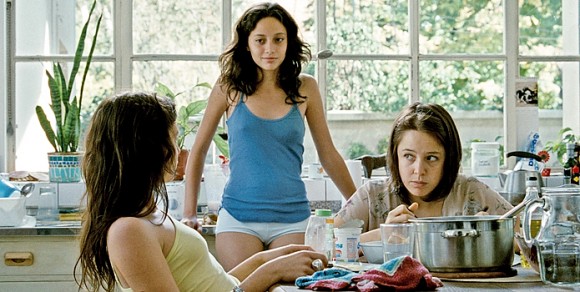 By Robert Koehler
By Robert Koehler
One of the more interesting projects in contemporary cinema is the inquiry into the realities of the mundane, its textures, rhythms, highs, lows (yes, even in the mundane), its music, the poetics of boredom. It’s perhaps coincidental, or not, that this year’s winner of Locarno’s Golden Leopard, Milagros Mumenthaler’s debut Back to Stay, and last year’s winner, Li Hongqi’s Winter Vacation, both embrace the mundane with precision but with different tacks. While Li’s film adopts an ultra-deadpan tone, Mumenthaler’s approach is closer to a contemporary take on Chekhov, alternately sad, kick-backed and bemused. Suitably, the film’s world is a home occupied by three sisters (Maria Canale, Martina Juncadella, Ailin Salas), whose world is changing before their eyes. Their grandmother has just died, and the three must take on more grown-up responsibilities. It’s wrong to carp, as some critics in Locarno did, that the film fails to sufficiently explain the sisters’ backgrounds and underscore their motives for their actions, such as the sudden decision by the youngest to up and leave with her boyfriend. Such explanation isn’t germane to Mumenthaler’s cinema. Rather, it’s enough to take in what she determines is material to her film, what exists within her framing. The absences in this shattered family speak volumes.
Elena (Andrei Zvyagintsev, Russia)—Contemporary World Cinema
 By Michael Sicinski
By Michael Sicinski
Unlike Andrei Zvyagintsev’s two previous films, there is no hint of mysticism or allegory in Elena. It’s a bracingly clear-eyed, materialist film in which everything is exactly what it is, and can hardly be said to represent much else. But like The Return and The Banishment, Zvyagintsev makes masterful use of slow, creeping camerawork and, especially, an extremely subtle rack focus. Things don’t leave the field of vision most of the time; we shift our perspective around them. Zvyagintsev is adept in slowly doling out narrative information about Elena (Nadezhda Markina) and Vladimir (Andrey Smirnov) through small but pregnant observational details. They are an elderly couple, probably in their sixties. They share an easy rapport. But eventually, we learn more about them and their respective families, and the conflict at the heart of Elena gradually emerges. They have only been married a few years; he is the one with the money. Elena’s adult son is an unemployed drunk living in a shitty public housing block with his layabout wife, flunky son and their new baby. Elena is supporting this family of losers, who now need even more money since the grandson has grades too awful for university and is therefore facing induction into the army (which means heading straight to the Chechen front). With a big wad of Vladimir’s cash, Sergey can bribe the kid’s way into college. Understandably, Vladimir doesn’t see this as his problem. Elena counters with the fact that he has willingly subsidized his own daughter’s life of partying, alcoholism and drug abuse. What makes Elena remarkable is the manner in which Zvyagintsev operates as a dramatic filmmaker of the mundane. No one is reducible to their class position, but no one can escape it either. Everyone has his reasons. It’s “Renoir noir.”
The Forgiveness of Blood (Joshua Marston, US/Albania/Denmark/Italy)—Contemporary World Cinema
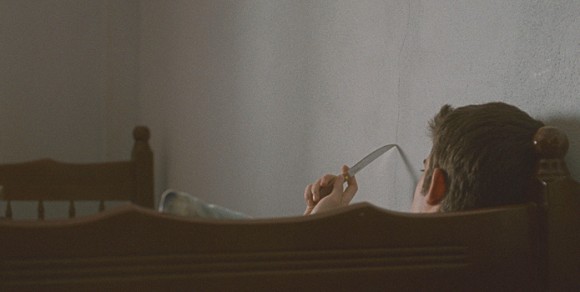 By Robert Koehler
By Robert Koehler
Particularly when Americans do it, filmmakers dropping in on a country to dramatize matters that are essentially foreign to their origins is usually as disastrous as Americans dropping in for war. The exceptions are rare: Briton Peter Strickland’s Katalin Varga is one of the few recent cases that succeed on all levels. American Joshua Marston, who demonstrated a certain lack of knowledge of the international drug trade in his first film Maria Full of Grace, has comparatively more control over the bizarre and seemingly intractable Albanian blood feud traditions that govern The Forgiveness of Blood. But there’s an unmistakably American indie patina that imprints and distorts this tale of a teen son trapped in a situation in which, despite his innocence of a crime committed by his father, ancient codes permit for his execution as payback. Marston understandably appears to relate more closely to the guy’s interest in web cafés and girls than the weird habits of old men, and this tends to mirror a national, American set of behaviours rather than get to the centre of the drama’s concerns.
Good Bye (Mohammad Rasoulof, Iran)—Contemporary World Cinema
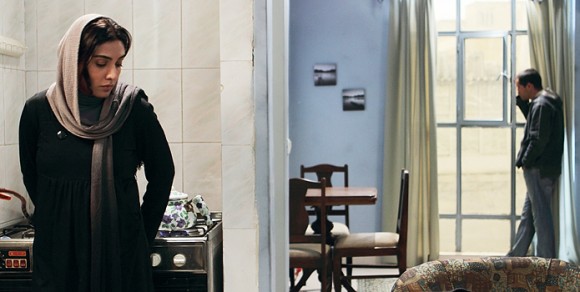 By Michael Sicinski
By Michael Sicinski
Ever since Iron Island, Rasoulof’s work has been characterized by an incisive visual style, modulated acting in the realist mode, and deep political conviction that has tended to remain on the level of allegory, although none the less unmistakable for that. Considering what has happened to Rasoulof—arrested along with Jafar Panahi, interrogated, potentially banned from working legally in Iran, his entire future a looming question mark—we’d probably have trouble even imagining what his latest film might look like, given the sheer miracle of its even having been made. Claustrophobic and shadow-laden where his previous film The White Meadows was expansive, Good Bye plays out almost entirely within middle-class interiors, private spaces that are nevertheless crisscrossed with the ever-present paranoia of Islamic totalitarianism. It’s a virtually first-person story of Noora (Leyla Zareh), a disbarred lawyer living alone in Tehran while her husband is working on a pipeline far from the city centre. We see her in her sparsely furnished apartment, dark and painted in deep midnight blues. In time, we learn that Noora and her husband were left-wing (or perhaps just anti-Ahmadinejad) activists, that her husband is in hiding due to articles he published, and that Noora is pregnant and trying to wheedle her way out of Iran by gaining permission to present at an academic conference. Good Bye is very much of a piece with Darioush Mehrjui’s middle-class kammerspiels; nevertheless, the complete desperation is very much an expression of Rasoulof’s own view of contemporary Iran, up and down the social strata. That the director, who may have narrowly escaped a sentence as harsh as Panahi’s, would opt to make Good Bye with his tenuous freedom takes some serious guts.
Gypsy (Martin Šulík, Slovakia / Czech Republic)—Contemporary World Cinema
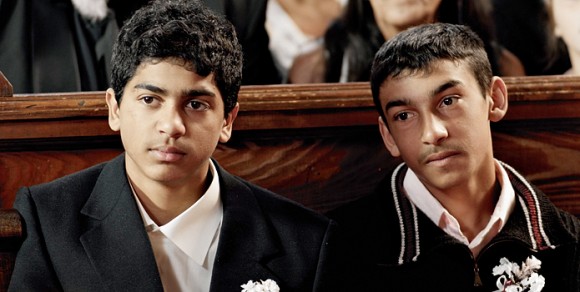 By Michael Sicinski
By Michael Sicinski
Gypsy is a film characterized by a certain predictability, even a patient rolling out of foregone inevitability. Although such a statement risks being mistaken for faint praise, it really does take nothing at all away from Šulík’s meticulous film to note that any attentive viewer understands where it’s going almost instantly. Essentially a retelling of Hamlet set within an impoverished, highly insular Romani community on the outskirts of a Slovakian village, Gypsy is upper-middlebrow cinema at its most skilful and high-toned, consistently managing to negotiate between its genre operations and its narrative particulars. Adam (Jan Mizigar) is a quiet, thoughtful “gypsy” in a scrappy, extroverted community. His father is killed and his mother soon remarries his uncle Ziga (Miroslav Gulyas), the local loan shark. Repeatedly visited by his father’s ghost, and drawn to various non-criminal options—the local (white) priest (Attila Mokos) tries to teach Adam to box; condescending liberal anthropologists offer to help him get into college—the conflict between Adam and Ziga is inevitably mapped onto the meaning and maintenance of Romani identity vs. selling out to the white (Slovakian) world. And, lest Ziga’s pride in Roma self-sufficiency and/or theft seem misplaced, Šulík is careful to display the array of racist indignities to which the Romas are subjected, from tragicomic banalities (a city bus blatantly bypasses Adam and his friend) to systematic oppression (a police interrogation scene). Performances and direction are exceptional, indeed reinvesting one of Shakespeare’s Greatest Hits with surprising freshness. Šulík’s visual approach, in particular, is unusual for such a character-driven film: Adam’s dislocation is reflected in desolate yet subtly evolving landscapes; scenes abruptly fade to black, like clipped punctuation; and Šulík provides jarring chapter-heading shots that feature Adam in medium-close-up, staring directly into the camera, daring us to disengage.
Leave It On the Floor (Sheldon Larry, Canada)—Canada First!
 By Jason Anderson
By Jason Anderson
There are many amazing things about Leave It on the Floor, but here’s my favourite of the moment. Not only does this fierce flambé of fabulosity feature a character named Queef Latina, but the person credited with playing said character (and playing her damn well) is known to the world at large as Miss Barbie-Q. Using either one of those names takes real balls, albeit the kind that stay tucked away between your legs lest they pop out during your Lady Gaga routine.
The prevention of any such wardrobe malfunction is of paramount importance to the characters in this flamboyantly nutty debut feature by Sheldon Larry, a Toronto expat and longtime Los Angeles resident whose extensive CV of television credits (all the way from King of Kensington to Boston Public!) never would have suggested that his true destiny was making such a singular creation as this. Set in the LA version of the Harlem drag-ball milieu immortalized in the 1990 documentary Paris Is Burning (its star Willi Ninja gets a well-deserved shoutout here), Leave It On the Floor is a queer-as-all-get-out musical drama that far outperforms and outclasses any of its glossier Hollywood competition of recent years, even without the presence of a lipsticked John Travolta.
Like so many musicals before it, this one tells the story of a promising upstart whose arrival causes a kerfuffle among a makeshift family of performers. Of course, the battle over new hunk Brad (Ephraim Sykes) is a pretext for an impressive variety of production numbers. Cannily crafted by lyricist Glenn Gaylord, composer Kimberly Bourse and a team of choreographers, the song-and-dance sequences range from an impromptu café tribute to Justin Timberlake, to an ecstatic celebration of the bowling alley as all-purpose LA meeting place, to a genuinely touching gospel number that reveals how even the most outrageous moniker contains a history of sadness and defiance. While Leave It on the Floor’s ambitions may sometimes exceed its reach (and budget), it’s continually rescued by its buoyant spirit, big heart and abundance of songs worth hearing more than once. This is what a Rent obsessive might create after a weekend-long bender of rum cocktails and RuPaul’s Drag Race DVDs.
Mr. Tree (Han Jie, China)—Contemporary World Cinema
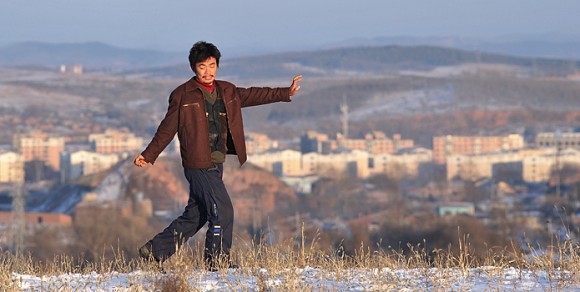 By Shelly Kraicer
By Shelly Kraicer
You’ve probably never seen a film from China quite like Han Jie’s gently absurd, somewhat twisted social-romance-comedy Mr Tree: there’s a bit of Fellini, a hint of Jia Zhangke, and a lot that’s utterly original in this eccentrically inventive movie. It’s extraordinary that a film like this passed Chinese state censorship and will be shown to local audiences there.
This is Han Jie’s second film under producer Jia Zhangke, with Jia’s own company XStream Pictures. The gifted Hong Kong cinematographer Lai Yiu-fai crafts extravagantly expansive crane shots and complex long takes full of expressive power, while Jia’s usual composer Lim Giong provides a subtly bouncy score. But the centre of the film is the sensational character actor Wang Baoqiang (who had key supporting roles in the 2003 Blind Shaft and the 2004 World Without Thieves). With his windmilling arms, canted body, spiralling voice, and anywhere-but-straight-ahead stare, Wang, as the protagonis, Shu (Chinese for “tree”), creates an unforgettable character: hilariously eccentric, deeply wounded, borderline mentally deficient, uncontrollably scrappy, but in certain imaginative ways, wildly creative. Shu’s odyssey takes him from home, a rundown village in China’s northeastern Jilin province, to the provincial capital Changchun. On the way, he somehow magically woos the beautiful deaf and dumb Xiao Mei. After an abortive stint as a school janitor, Shu is haunted by visions of his dead father and brother. He returns home for a cataclysmic wedding, then retreats into his own imagination, where his fantasy and his reality clash and confound each other.
The Patron Saints (Brian M. Cassidy & Melanie Shatzky, Canada/US)—Canada First!
 By John Semley
By John Semley
People say that death is the fundamental shared human fear, the grand existential bogeyman lurking in the shadows of our waking consciousness. But really, it’s the process of dying that’s more terrifying, and that’s what imbues The Patron Saints with its dragging sense of disquiet. An impressively stylized document of the institutional apparatus of aging and dying, The Patron Saints focuses on the lives of elderly men and woman (and, to a lesser extent, their hired caregivers) in a nursing home. The exact location is left deliberately ambiguous—though some credit roll snooping suggests it’s somewhere in New York State—such that the film can unmoor itself a bit from politics (if that’s possible), refusing to function as a critique of one-or-another health care system so that it can function as a critique of institutions writ large.
Narrated, kind-of, by James, a man whose apparent mental spryness and earthy wit belie his hunched immobility, The Patron Saints hovers through the home, lingering on residents calling for help in Hungarian, receiving hand massages from orderlies, and laboriously stirring cream into cups of coffee. (This last sequence is punctuated by an offscreen woman repeating “Can I have a cup of coffee, please?” and “I hope that you choke, Amen” with an echoing flatness that recalls a Throbbing Gristle lyric sheet.)
It’s heavy, confrontational stuff, to be certain, and Cassidy and Shatzky hammer it home a bit calculatingly. An extended sequence of garbage being unceremoniously dumped at a nearby facility is thumpingly obvious, betraying the more muted allegorical and compositional gestures deployed elsewhere. Still, the filmmakers should be credited with crafting a film that’s both lyrical and difficult (an unusual combination) without edging too far into exploitative, wretched-of-the-Earth grotesquerie.
Sleeping Beauty (Julia Leigh, Australia)—Special Presentations
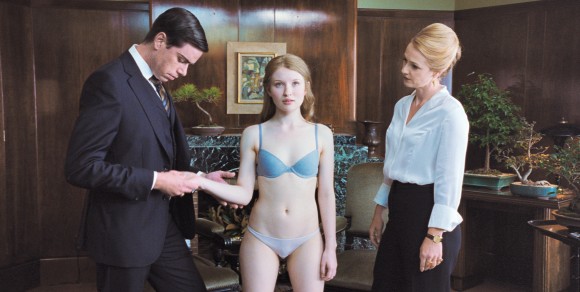 By Kiva Reardon
By Kiva Reardon
If Zack Snyder had read a hypothetical Art Films for Dummies manual, the result might look like Sleeping Beauty. Beyond sharing Emily Browning as lead, Julia Leigh’s first feature slides like a palimpest over Sucker Punch: instead of burrowing behind Browning’s dazed doe eyes to explore her unconscious fantasies a la Snyder, Leigh’s film observes her in the flesh while she’s out of it. It’s a close call as to which film is worse, as both, in their differing modes, pay lip service to exploring female sexuality in the interest of pointless and neutered provocations.
From the outset, we are to understand that Lucy (Browning) doesn’t mind selling her body for cash, as we watch her methodically swallowing a stomach tube as a paid participant in a science experiment. In the spectrum of body commodification, medical experiments are generally the most socially acceptable way to go about it. But, this being such an ambitious film, Lucy’s trajectory rapidly proceeds to prostitution, then to waitressing at Eyes Wide Shut-style dinner parties/capitalist orgies, and finally to becoming the titular “sleeping beauty”: willingly drugged by her ice-queen madame (Rachael Blake), she is sent to bed and left as a malleable doll for an uber-rich white male clientele told they can do with her as they will—anything short of penetrative sex, that is. (“My vagina isn’t a temple,” says Lucy in half-mock protest.)
This caveat, which is often repeated (like many points in this redundant film), is worth noting as it is understandable in narrative terms: the merchandise must remain unsullied, and the men are all in their Viagra years anyway. But it also suggests a highly heteronormative view of sex and rape as simply boiling down to penetration. Whether Leigh is critiquing this or not is hard to decipher as, like most themes in the film, it is simultaneously overstated and underexplored. There is no doubt as to the underlying eroticism of the Sleeping Beauty fable, as well as a broader cultural fascination with the vulnerability of sleeping women, encompassing everything from A Nightmare on Elm Street to Kill Bill to TV’s Dollhouse (all of which are better than this film). But Leigh doesn’t do anything new with the metaphor, instead simply deploying vapid art-cinema poses. The gaps in the narrative seem lazy rather than evocative, just as the so-called “provocative” sex scenes never really push the boundaries of disgust (thus never causing the audience to question their relationship to the acts they are watching). But it is the film’s ending, when Lucy inexplicably decides she wants to know what goes on in the room as she sleeps, that pushes the film once and for all into the realm of the purposefully obtuse: it’s not so much that she needs to know as that Leigh needs an ending. Not worth thinking about beyond the question of what it was doing at Cannes, Sleeping Beauty is best laid to rest, as it won’t disturb.
Smuggler (Katsuhito Ishii, Japan)—Midnight Madness
 By Michael Sicinski
By Michael Sicinski
Those of us who thoroughly enjoyed Takashi Miike’s recent 13 Assassins but were a bit nonplussed by its overall normalcy may well consider Smuggler something of a transmission from an alternate universe, a place where the basic ingredients of a solid-state studio picture really can exist side by side with bugfuck lunacy. Ishii has been just on the verge of becoming a major Japanese filmmaker for the last several years; with Smuggler, all the pieces are in place for a complete breakthrough. Based on a manga series by Shohei Manabe, the story concerns ne’er-do-well Kinuta (Satoshi Tsumabuki), a self-professed slacker, deaf in one ear, a guy who wanted to be an actor but just gave up. After racking up massive gambling debts, he’s forced by mob enforcers to work for a ruthless banker (Yasuko Matsuyuki) as part of a smuggling team. Basically a group of no-questions-asked long-haul truckers, the smugglers typically move gangsters’ dead human freight. This scenario allows Ishii to set up two basic tonal poles for Smuggler, ones which he keeps in near-perfect balance throughout. There’s a sort of cowboy-inflected Bildungsroman centred on Kinuta’s mentorship from long-term smuggler Jo (Masatoshi Nagase). And against this aspect, Ishii introduces a yakuza world as outsized and hyperviolent as anything found in comparable manga-derived cinema: the main perpetrators of the mayhem are a pair of indestructible assassins (and maybe lovers—it’s left ambiguous) called Vertebrae (Masanobu Ando) and Viscera (Ryushin Tei). Yes, there is torture and spatter. But what makes Smuggler such an impressive piece of work is the fact that Ishii manages to convincingly articulate the style and form of Asian “extremity” with certain sturdy, classical cinematic values, without ever making this combination seem calculated. As a result, Ishii’s vision will reach a wider audience. And that’s called smuggling.
Take This Waltz (Sarah Polley, Canada)—Gala
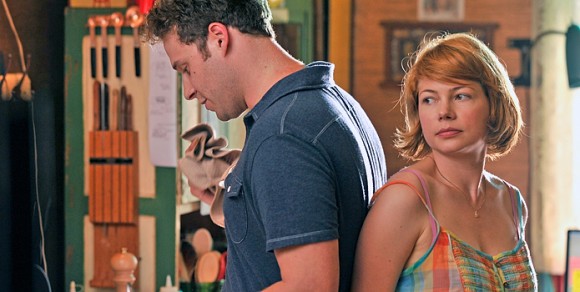 By Adam Nayman
By Adam Nayman
The first sign that Take This Waltz is going to be a mite too writerly comes in the very first scene, when Toronto parks worker Margot (Michelle Williams) is coerced by a group of Nova Scotian historical re-enactors into pantomiming flogging an adulterer. As a cold open for a film that’s going to quickly become about the emotional anguish of a young married woman debating between her homebody husband (Seth Rogen) and a hardbody rickshaw driver (Luke Kirby), this tableaux is more than suggestive: it’s like a flashing neon sign announcing the author’s intentions.
And make no mistake, Take This Waltz has a certain self-flagellating aspect, if we are to believe that there are any correspondences—however superficial or circumstantial—between the director’s first original feature script and the dissolution of her real-life marriage. Another critic said after a screening that Take This Waltz felt like a first draft, and it’s an apt observation. Not only because there are things in it that a good editor would take out (like maybe the whole third act), but also because the best parts have the headlong, unmediated quality of automatic writing. Some viewers will be nauseated by Williams and Rogen’s cooing bedroom baby-talk exchanges, but I bought them as signifiers of a desexualized intimacy. I even bought the idea of Michelle Williams as a desexualized presence, largely because of Rogen’s surprisingly resourceful performance as a guy whose cuddliness may also be the path of least resistance.
What I didn’t buy were Margot’s furtive meetings with Mr. Rickshaw (is his job an Allan King reference in a film that also name checks Mon oncle Antoine?), nor his hobby as a sketcher of tortured pencil portraits, nor the erotic charge of their daily flirtations, which are mostly overwritten (especially Polley’s po-faced inversion of When Harry Met Sally‘s signature scene, which finds Williams trying to silently suppress an orgasm in a restaurant rather than loudly and falsely announcing one). Yes, there’s something harrowing in Margot’s should-I-stay-or-should-I-go dilemma, and Polley is nothing if not conscientious in making sure we understand each and every potential pitfall for all involved. She’s so conscientious, in fact, that she keeps the film going past at least two logical and dramatically satisfying potential end points. And she consistently undercuts her best ideas, like tethering Margot’s rushing emotions to pop songs—smart when it’s the Buggles’ “Video Killed The Radio Star” (a song about what’s lost when one trades in an older model), deadly when it’s Leonard Cohen’s title track, laid over an arty, “risqué” montage that’s nothing but showing off (and pretty silly to boot).
Hopefully, some other critics will inventory the film’s other annoyances, like its Egoyanesque commitment to authentic Toronto locations (if not authentic Torontonian geography) and the literal car wreck of a cameo by Sarah Silverman, who is not playing Rogen’s sister so much as that tired old device of the Wacky Fuck-up Who Speaks the Truth. (cf. Michael Shannon in Revolutionary Road.) Noting these shortcomings shouldn’t mean ignoring what’s good about Take this Waltz, which is a more urgent and accomplished piece of filmmaking than Polley’s debut Away From Her (which had the benefit of canonical source material and seasoned stars). Polley puts more on the line here, and ultimately loses a split decision. Nothing she should beat herself up over.
Volcano (Rúnar Rúnarsson, Denmark/Iceland)—Discovery
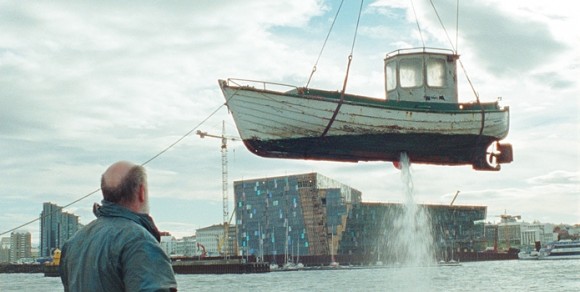 By Robert Koehler
By Robert Koehler
Although it begins with some extraordinary footage (selected from the 1974 documentary Fire on Heimaey) of Icelandic volcanic eruptions swamping a tract of home and setting off fires on the island of Heimaey, for the first 40 minutes writer-director Rúnar Rúnarsson’s humdrum movie would better be titled Asshole. A crusty old fart, who enjoys terrorizing the kids at the school where he’s worked as a glorified janitor for years, retires, considers killing himself by sucking on carbon monoxide, and instead decides to live on to direct his general disgust at his family members. His wife and grown children know he’s an asshole, but the kids can’t figure out why she still puts up with him. His leaky fishing boat unfortunately doesn’t sink and take the old dude down for good. No, instead, after a round of geriatric sex, his wife has a severe stroke that turns her into a moaning, groaning invalid who can barely eat and elicits his deeply closeted humanity. Asshole is apparently capable of becoming Angel as he begins to lovingly care for her at home, but it’s all too horribly calculated in Rúnarsson’s obvious scenario, which is filmed in a dim brand of Super 16 that absorbs the blandest tendencies of British kitchen-sink realism. No amount of spacey Sigur Rós music (specifically Kjartan Sveinsson) can lift this out of its blah domestic muck.
Whores’ Glory (Michael Glawogger, Austria/Germany)—Real to Reel
 By Christoph Huber
By Christoph Huber
Michael Glawogger, Austria’s most enigmatic filmmaker, continues his pendulum movement between fascinatingly diverse fictions—as evidenced by 2009’s one-two yin-yang-punch of Contact High and Kill Daddy Goodnight—and globe-spanning documentaries like the 1998 Megacities or the 2005 Workingman’s Death. Following in the latter’s footsteps, Glawogger’s docu-essay Whores’ Glory caps, as the press book biography dryly states, “his trilogy about working environments.” First off is Thailand, where prostitution is outlawed (and officialy does not exist, but of course it does): in a “fish tank” in Bangkok, the girls sit behind glass and are chosen by number after eye contact. “The City of Joy” in Faridpur, Bangladesh, is a multi-story brothel where 600 to 800 prostitutes live (with their children) and work in extremely confined space, a matriarchal ghetto governed by a “council of mothers.” Finally, there’s “La Zona” [de tolerancia] in Reynosa, Mexico, near the Texan border, through which tricks on the lookout circle slowly in their cars over dirt roads. A designated triptychon, this formally achieved film follows the classical construction of an altarpiece in the tradition of Hieronymus Bosch, moving from the sterile, almost ethereally presented Buddhist Thai “Paradise” through the chaotic miasma of “The World” in Islamic Bangladesh into the near-entropic “Hell” of the deeply Catholic Zona of Death—which, irritatingly, is also the place most vibrating with passion (abetted by heart-rending interludes from the local norteño ensemble). Thriving on contradiction and observational curiosity as usual, Glawogger still resolutely rejects social cause-pandering, but scratches for something deeper by contrasting the rituals of love (for sale) in three different cultures, religions and economies: a look not just at prostitution, but the relationships between men and women in contemporary society that yields telling and ambivalent insights. Another major work, and the only Austrian feature-length film of importance in the upper echelons of the festival circuit this year.
cscope2

